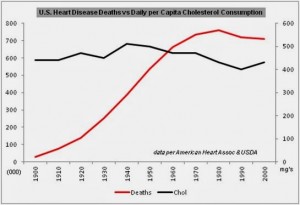By Peter Wright, NTP
This post is part of a six part series on fat. Please be sure to check out the other posts in this series. Return to Part 1 for links to the other posts in the series.
Part 2: Heart Disease is NOT the Result of Fat Consumption
Part 3: What are SFA, MUFA, PUFA, and Omega 3 & 6 Fats?
Part 4: How to Avoid Unhealthy BAD Fats
Part 5: How to Balance Your Fat Intake for Optimum Health
Part 6: The Buyer’s Guide for Fat including Cooking Safely with Fats
The “anti-saturated fat agenda” can be traced back to a comparative health study coordinated by Ancel Keys in 1958 called the Seven Countries Study comparing fat consumption to heart disease rates in seven different countries. The study concluded cholesterol levels predicted heart disease, saturated fat consumption predicted cholesterol levels, and monounsaturated fats prevented heart disease.
However, there were issues with the conclusion. The Americans sampled had a coronary death rate forty times higher than the Cretans, but the Cretans consumed three and a half times the fat.1 The study is also criticized for only including 7 of the 22 countries studied. When all 22 are included the correlation between fat consumption and heart disease disappears.
 |
| Fat Consumption and Heart Disease |
At the time of the study the medical community and government were under pressure to do something about the escalating rates of heart disease. They jumped on the results and ignored the early critiques of the study and its inherent contradictions. America loves and enemy and the study provided one – fat! There’s only one problem – fat is essential to our health.
“The idea that saturated fats cause heart disease is completely wrong, but the statement has been “published” so many times over the last three or more decades that it is very difficult to convince people otherwise unless they are willing to take the time to read and learn what all the economic and political factors were that produced the anti- saturated fat agenda.”
Dr. Mary Enig
I assembled some readily available government data to compare the relationship between saturated fat, cholesterol, and heart disease, The first graph below compares heart disease deaths to fat consumption over the last one hundred years in the US. The climb in the red line, deaths due to heart disease, is alarmingly steep, but the black line, consumption of saturated fat, is almost flat. Saturated fat consumption increased 8% while deaths increased almost 2500%! Monounsaturated fat increased 53% but didn’t have the life saving effect predicted in the Seven Countries Study.
 |
| Heart Disease Deaths vs. Fat Consumption |
In the next graph I compare cholesterol consumption versus deaths due to heart disease. Once again, it’s hard to see the correlation predicted in the study. Total cholesterol consumption actually decreased over the one hundred years.
 |
| Heart Disease Deaths vs. Cholesterol Consumption |
Cholesterol is produced by the body. If the levels are too low the body produces more. One of the functions of cholesterol is to repair inflammation and damage to arteries and veins. Consumption of fat does not increase cholesterol levels. Inflammation increases cholesterol levels. So the correlation between cholesterol and heart disease may be correct, but the cause of high cholesterol is not fat consumption. Heart disease is the result of the over-consumption of processed food.
“Simply stated, without inflammation being present in the body, there is no way that cholesterol would accumulate in the wall of the blood vessel and cause heart disease and strokes. Without inflammation, cholesterol would move freely throughout the body as nature intended. It is inflammation that causes cholesterol to become trapped. … What are the biggest culprits of chronic inflammation? Quite simply, they are the overload of simple, highly processed carbohydrates (sugar, flour and all the products made from them) and the excess consumption of omega-6 vegetable oils like soybean, corn and sunflower that are found in many processed foods. … There is but one answer to quieting inflammation, and that is returning to foods closer to theirnatural state. By eliminating inflammatory foods and adding essential nutrients from fresh unprocessed food, you will reverse years of damage in your arteries and throughout your body from consuming the typical American diet.”2
Dr. Dwight Lundell, past Chief of Staff and Chief of Surgery at Banner Heart Hospital
The facts simply don’t support the relationship between fat consumption and the drastic increase in heart disease over the last 100 years. Our saturated fat consumption has remained steady over that period while our mono and polyunsaturated consumption has increased. The Nurses’ Health Study which tracked 127,000 nurses over twenty years found no statistically significant correlation between fat and cholesterol intake and heart disease.
In Part 3 of the series I’ll explain the differences between these categories of fats and why they’re important.
1 Gary Paul Nabhan, Why Some Like It Hot: Food, Genes, and Cultural Diversity , Island Press; 1 edition (June 7, 2006)
2 Dr. Dwight Lundell, (past Chief of Staff and Chief of Surgery at Banner Heart Hospital , Mesa , AZ.), Heart Surgeon Speaks Out On What Really Causes Heart Disease, Prevent Disease.com, Thu, 01 Mar 2012
Photo 1 – Image courtesy thampapon1- FreeDigitalPhotos.net
Latest posts by Peter Wright, NTP, CGP (see all)
- Dehydrated Broth – Making It Easy to Drink Broth Every Day! - March 11, 2017
- Lose 10 lbs DURING the Holidays - November 19, 2016
- Finding Good Oils - February 7, 2016


No comments yet.